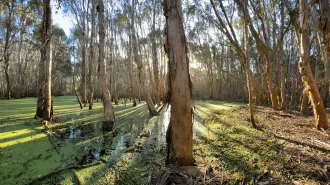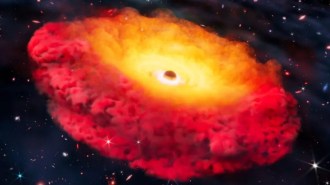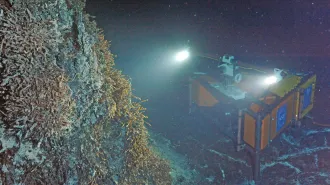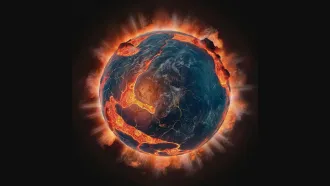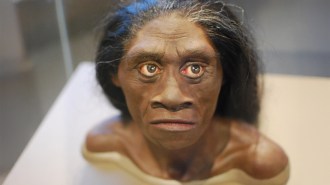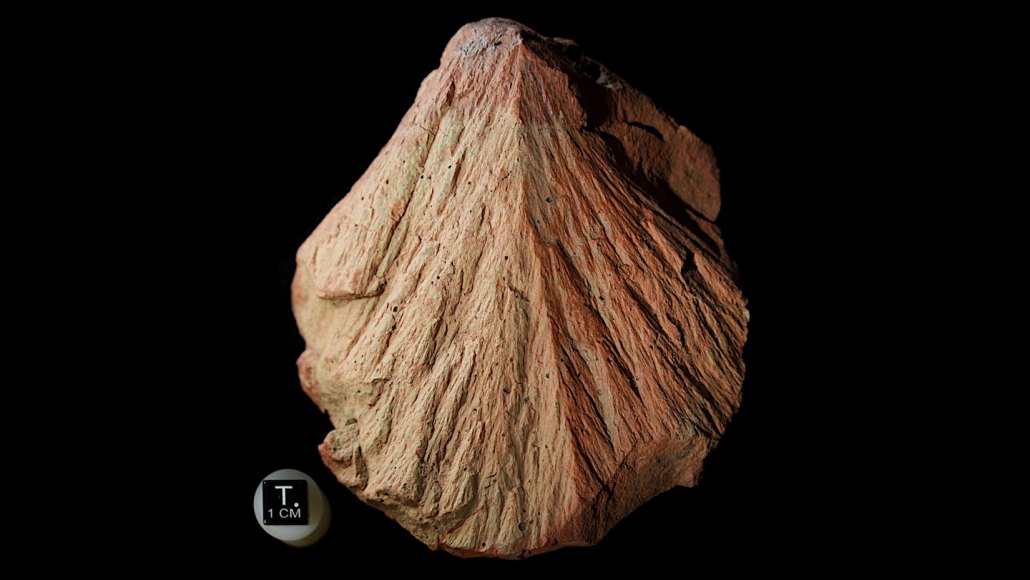
Craters on Earth are no longer visible for asteroid impacts that happened over a billion years ago. But some are marked by “shatter cones” (one shown), formed as a shock wave penetrated deep into the ground, fracturing everything in its path.
Alec Brenner/Harvard University
In a remote desert, scientists have discovered one of Earth’s oldest asteroid impacts. It dates to well over a billion years ago, to a time when our planet was inhabited solely by single-celled life.
The impact happened at what’s now called North Pole Dome in northwest Australia, its presence hidden within ragged, red rocks made of lava that erupted 3.47 billion years ago. Scattered here and there are sandstones that hold some of the planet’s oldest microbial fossils, which grew in bubbling hydrothermal pools and shallow seafloors. Those fossils and the impact could be crucial for studying past life on Mars, geologist Alec Brenner and colleagues report in the July 9 Science Advances.
These rocks are “the best analogs we have on Earth to what a lot of the surface of Mars look[ed] like” 3 billion to 4 billion years ago, says Brenner, of Yale University. During that era, the Red Planet was periodically wet and may have harbored life.
The team’s new finding could help scientists predict how Martian microbial fossils might appear if a rover encounters them. Many rocks on Mars’ surface have been altered by things such as hot fluid flows or meteor impacts, which can obscure real fossils or create bubbly structures that resemble tiny fossils but aren’t.
The newly discovered structure, “is a really cool place for people to learn what the effects of an impact happening on fossils and early life would look like, if they went to Mars and tried to look for the same thing,” Brenner says.
What was it like on early Earth and Mars?
Scientists believe that early Earth was pummeled by asteroid impacts; the moon and Mars are littered with giant craters, some over 4 billion years old. In contrast, the oldest known impact structure on Earth is just 2.23 billion years old. Unlike Mars and the moon, Earth’s oldest craters have been obliterated by erosion and plate tectonics, which melts and recycles the crust.
Brenner accidentally discovered the new site — now called the Miralga impact structure — while driving across North Pole Dome in 2023, during his work at Harvard. When he stopped to show his field assistants some attractive lava rocks, he noticed that some of them appeared to have been chiseled into cone shapes, with their tips pointed skyward. These “shatter cones” formed as the shock wave from a massive impact penetrated kilometers into the planet’s crust.
“The crater itself has been eroded away” along with three kilometers of rock, Brenner says. “All we’re looking at is the deep, deep underneath of the crater that’s been whacked really hard.”
-
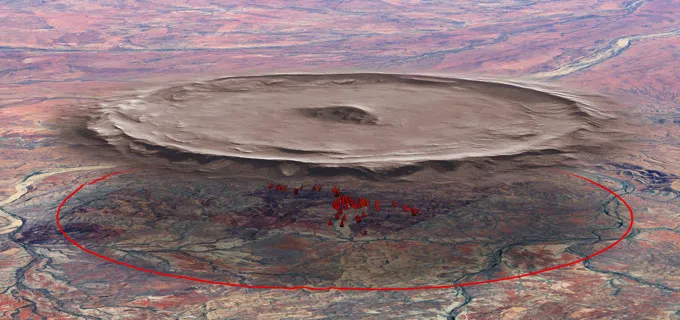
Shatter cone-shaped rocks (red) mark a spot in the Australian desert where an asteroid slammed into Earth. Erosion has long since erased the original crater (illustrated, hovering in its original position). Alec Brenner/Harvard University -

The tips of the cones (red) point toward the epicenter (bullseye) of the original impact. These shattered rocks, now exposed due to erosion, were originally about three kilometers below the crater. Alec Brenner/Harvard University
It’s a surprising find, because scientists have studied this area for decades, says Aaron Cavosie, an impact geologist at Curtin University in Perth, Australia. “Sometimes these things are just hiding in plain sight.”
Brenner, Cavosie and their colleagues mapped hundreds of shatter cones across an area nearly 7 kilometers wide. The tips of the cones pointed like compass needles toward a central point overhead, where a 1- or 2-kilometer-wide meteorite had struck — sending shock waves into the earth and forming a crater estimated to be 16 kilometers across.
Most of the shattered rocks were 3.47 billion years old. But Brenner’s team found that in one area, the shatter cones extended into an overlying rock layer only 2.77 billion years old —meaning that the impact must be younger than that. Brenner estimates it happened between 1.2 and 1.8 billion years ago, based on his preliminary analysis of Earth’s magnetic field at the time of impact, which is preserved in the rocks.
Cavosie is especially excited about the 3.47-billion-year age of the rocks that were hit. “There’s no rocks on Earth older than these basalts that preserve evidence of shock deformation” from an impact, he says. The rocks contain rare “shocked” titanium minerals, denser than those normally found on Earth’s surface, which recorded the high pressure of the strike.
From Earth’s craters to life on Mars
These Earthly volcanic basalts are similar to those on Mars, particularly in places like Jezero Crater, which may have intermittently held a lake 3 billion to 4 billion years ago. NASA’s Perseverance rover has explored that crater and examined layers of sandstone and mudstone formed by flowing water. It drilled into those rocks and collected seven cores, which may eventually be brought to Earth and studied for signs of life. One of those rock samples contains strange “leopard spot” structures that could have been created by ancient microbes.
Any potential biomarkers in those Martian rocks are likely to be ambiguous, altered by hydrothermal fluids, chemical weathering or meteor impacts, says Michaela Dobson, a Brisbane-based geologist with the New Zealand Astrobiology Network, who is not part of Brenner’s team.
Ancient fossils in the North Pole Dome area were altered by similar processes, including — we now know — a large impact. “We can go back to these environments with fresh eyes,” Dobson says, to understand how the fossils were altered — and how they might appear in Martian rocks.
